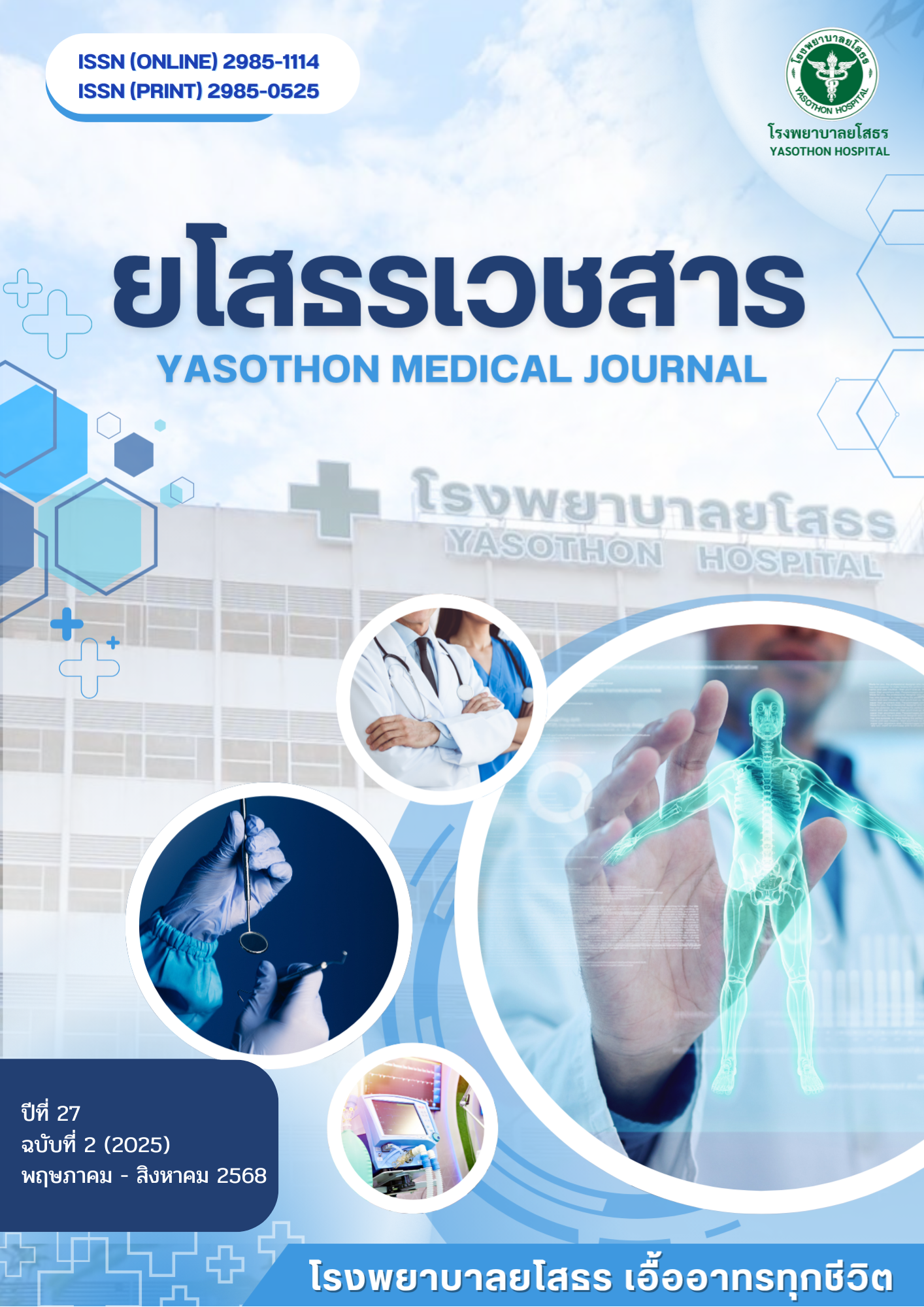Development of Self–care Management Promotion Model for Heart Failure Patients at the Heart failure Clinic in Yasothon Hospital
Keywords:
Heart Failure Patients, Heart Failure Clinic, Self-Care Management, Quality of LifeAbstract
This research and development aimed to develop a self-care management promotion model for heart failure patients at the heart failure clinic in Yasothon Hospital and evaluate the effect after development. The sample was divided into two groups, specifically selected: a multidisciplinary team of 9 people and 90 heart failure patients receiving services at a heart failure clinic. The research process is divided into 3 phases: Phase 1: Draft Prototype Analysis and Synthesis (R1D1). The prototype was developed by studying the problems and analyzing the situation from medical records and key performance indicators, to prepare a draft of the self-care management promotion model. Phase 2: Prototype Development (R2D2): The developed model is tested, and the study results are adjusted and developed. Phase 3: test the effectiveness of the new knowledge prototype (R3D3). Used the self-care management promotion model that was developed and summarized. The Data were collected from May 2024 to April 2025. The research tool includes: Phase 1, the medical recording form, and the Open-ended questions line. Phase 2: the self-care management promotion model. Phase 3 includes data collection form, the self-care assessment form for heart failure patients. The quality of life of heart failure questionnaire and the six-minute walk test (6-MWT) recorder. Data were analyzed by mean, standard deviation, and the T-test.
The result showed that the self–care management promotion model has been developed with a multidisciplinary team in a systemic care of patients and patients with heart failure after receiving self-care management promotion model were significantly better than before using this service p<.05 level in Self-care management, Quality of life, six minute walk test (6-MWT) and non of the sample readmission within 6 months.
The results of this study suggest that the self-care management promotion model should be implemented in heart failure clinics and patients with other chronic diseases to help them effectively manage self-care, attain a better quality of life (6-MWT), and reduce the rate of readmission.
Keywords: Heart Failure Patients, Heart Failure Clinic, Self-Care Management, Quality of Life
References
Yancy CW, Jessup M, Bozkurt B, Butler J, Casey DE Jr, Drazner MH, et al. 2013 ACCF/AHA guideline for the management of heart failure: a report of the American College of Cardiology Foundation/American Heart Association Task Force on Practice Guidelines. J Am Coll Cardiol 2013; 62(16): e147-239. doi: 10.1016/j.jacc.2013.05.019. PubMed PMID: 23747642.
Bonow RO, Mann DL, Zipes DP, Libby P. Braunwald’s heart disease: a textbook of cardiovascular medicine. 2 vols. 9th ed. Philadelphia: Elsevier Saunders; 2012.
กองยุทธศาสตร์และแผนงาน สำนักงานปลัดกระทรวงสาธารณสุข. สถิติสาธารณสุข 2565 [อินเตอร์เน็ต]. 2565 [เข้าถึงเมื่อ 7 เมษายน 2568]. เข้าถึงได้จาก: https://spd.moph.go.th/wp-content/uploads/2023/11/Hstatistic65.pdf
กัญญา สุขะนันท์, ซาลีฮา สาและ, ชนัยกานต์ แก้วอุทัย. การพัฒนารูปแบบการพยาบาลฟื้นฟูสมรรถภาพผู้ป่วยโรคหัวใจล้มเหลว โรงพยาบาลปัตตานี. วารสารคณะพยาบาลศาสตร์ มหาวิทยาลัยบูรพา เมษายน–มิถุนายน 2565; 30(2): 67-80.
รังสฤษฏ์ กาญจนะวณิชย์. Heart failure management programme. ใน: อภิชาต สุคนธสรรพ์, รังสฤษฎ์ กาญจนะวณิชย์, บรรณาธิการ. Heart Failure. เชียงใหม่: ไอแอมออร์เกไนเซอร์แอนด์เวอร์ไทซิ่ง; 2547. หน้า 219-32.
Ditewing JB, Blok H, Havers J, Veenendaal HV. Effectiveness of self-management interventions on mortality, hospital readmissions, chronic heart failure hospitalization rate and quality of life in patients with chronic heart failure: A systematic review. Patient Educ Couns 2010; 78(3): 297-315.
doi: 10.1016/j.pec.2010.01.016. PubMed PMID: 20202778.
Woda A, Haglund K, Belknap RA, Sebern M. Self-care behaviors of African Americans living with heart failure. J Community Health Nurs 2015; 32(4): 173–86. doi: 10.1080/07370016.2015.1087237. PubMed PMID: 26529103.
งานเวชระเบียนและสถิติ. รายงานสถิติประจำปีงบประมาณ พ.ศ. 2565. ยโสธร: โรงพยาบาลยโสธร; 2566.
Joynt KE, Jha AK. A path forward on Medicare readmissions. N Engl J Med 2013; 368(13): 1175-7.
doi: 10.1056/NEJMp1300122. PubMed PMID: 23465069.
สมาคมแพทย์โรคหัวใจแห่งประเทศไทย ในพระบรมราชูปถัมภ์. แนวทางเวชปฏิบัติเพื่อการวินิจฉัยและการดูแลรักษาผู้ป่วยภาวะหัวใจล้มเหลว พ.ศ. 2562. สมุทรปราการ: เนคสเตป ดีไซน์; 2562. หน้า 19-23.
Heart Failure Society of America; Lindenfeld J, Albert NM, Boehmer JP, Collins SP, Ezekowitz JA, Givertz MM, et al. HFSA 2010 Comprehensive heart failure practice guideline. J Card Fail 2010; 16(6): e1-194. doi: 10.1016/j.cardfail.2010.04.004. PubMed PMID: 20610207.
ธีริศรา อุณวงศ์. ผลของโปรแกรมส่งเสริมการจัดการตนเองต่อคุณภาพชีวิตของผู้ป่วยหัวใจล้มเหลว โรงพยาบาลกุมภวาปี. วารสารวิชาการสำนักงานสาธารณสุขจังหวัดมหาสารคาม ตุลาคม 2566 – มกราคม 2567; 8(15): 175-83.
Nejadshafiee M, Bahaadinbeigy K, Kazemi M, Nekoei-Moghadam M. Telenursing in incidents and disasters: A systematic review of the literature. J Emerg Nurs 2020; 46(5): 611-22.
doi: 10.1016/j.jen.2020.03.005. PubMed PMID: 32360295.
Donabedian A. An introduction to quality assurance in health care. New York: Oxford University Press; 2003.
Riegel B, Carlson B, Moser DK, Sebern M, Hicks FD, Roland V. Psychometric testing of the self–care of heart failure index. J Card Fail 2004; 10(4): 350-60. doi: 10.1016/j.cardfail.2003.12.001. PubMed PMID: 15309704.
Faul F, Erdfelder E, Buchner A, Lang AG. Statistical power analyses using G*Power 3.1: Tests for correlation and regression analyses. Behav Res Methods 2009; 41(4): 1149-60. doi: 10.3758/BRM.41.4.1149. PubMed PMID: 19897823.
จอม สุวรรณโณ, เรวดี เพชรศิราสัณฑ์, ปุณยวีร์ ประเสริฐไทย, อรุณศรี จันทร์ประดิษฐ์, วงรัตน์ ใสสุข. การดูแลตนเองของผู้ป่วยหัวใจล้มเหลวเรื้อรัง. วารสารสภาการพยาบาล มกราคม-มีนาคม 2551; 23(1): 35-47.
Rector TS, Kubo SH, Cohn JN. Patient’s self-assessment of their congestive heart failure: Content, reliability and validity of a new measure: The Minnesota living with heart failure questionnaire. Heart Failure 1987; 3: 198-219.
พวงผกา กรีทอง. โมเดลเชิงสาเหตุของคุณภาพชีวิตผู้ป่วยที่มีภาวะหัวใจวาย [วิทยานิพนธ์ปริญญาดุษฎีบัณฑิต]. กรุงเทพฯ: จุฬาลงกรณ์มหาวิทยาลัย; 2550.
บุญชม ศรีสะอาด. การวิจัยเบื้องต้น. พิมพ์ครั้งที่ 10. กรุงเทพฯ: สุวีริยาสาส์น; 2560. หน้า 120-1.
ไวยพร พรมวงค์, อภิญญา ศิริพิทยาคุณกิจ, ขนิตฐา หาญประสิทธิ์คำ. การประเมินผลลัพธ์ระบบการบริการโดยทีมสหสาขาในคลินิกหัวใจล้มเหลว โรงพยาบาลรามาธิบดี. รามาธิบดีพยาบาลสาร พฤษภาคม-สิงหาคม 2562; 25(2): 166-80.
อภิญญา วงศ์พิริยโยธา, กัญจน์ณิชา เรืองชัยทวีสุข, รุ่งนภา ธนูชาญ. ผลของโปรแกรมการสอนเกี่ยวกับการป้องกันภาวะหัวใจล้มเหลวและการติดตามทางโทรศัพท์ต่ออาการและคุณภาพชีวิตในผู้ป่วยโรคลิ้นหัวใจพิการ. พยาบาลสาร มหาวิทยาลัยเชียงใหม่ มกราคม-มีนาคม 2567; 51(1): 29-43.
ฐิติมา ทาสุวรรณอินทร์, ลินจง โปธิบาล, ทศพร คำผลศิริ. ผลของการส่งเสริมการจัดการตนเองต่อคุณภาพชีวิตและอัตราการกลับมารักษาซ้ำของผู้สูงอายุที่มีภาวะหัวใจล้มเหลว. พยาบาลสาร ตุลาคม-ธันวาคม 2562; 46(4): 108-21.
Downloads
Published
Versions
- 2025-09-23 (2)
- 2025-09-23 (1)
How to Cite
Issue
Section
License
Copyright (c) 2025 YASOTHON MEDICAL JOURNAL

This work is licensed under a Creative Commons Attribution-NonCommercial-NoDerivatives 4.0 International License.
บทความที่ได้รับการตีพิมพ์เป็นลิขสิทธิ์ของยโสธรเวชสาร







